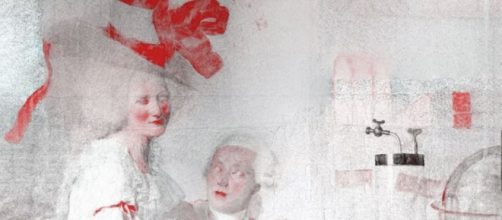The Met thinks it has done a good thing as you can see in this screamer on its website: “The Metropolitan Museum of Art Announces Transformative New Insights into 18th-Century Painting by Jacques-Louis David after Discovering Underlying Composition.” “Transformative”? If I were Jacques-Louis whose work was x-rayed, exposing an image I rejected, compromising my reputation for stark, spare portraits, I’d be mortified.
Jacque-Louis David is long-celebrated for his austere, clean-lined portraits with zero background detail. A well-known example is the unalloyed likeness of Portrait of Madame Recamier without a speck of jewelry.
There is nothing in the picture but her reclines on a couch in quiet repose. Vintage Jacque-Louis.
Marring a reputation
But the Met, armed with infrared reflectography and macro-X-ray fluorescence, peeped under a portrait painted of the same image. Except the one underneath is ostentatious and splashy, not simple at all. What’s worse, the underpainting doesn’t fit the subjects, the famous French chemists Marie-Anne Lavoisier and Antoine Laurent. Together they discovered the composition of water and oxygen.
In the image that the Met exposed, you’d never know the couple had anything to do with advancing science. Hyperallergic describes their appearance as “more elite than revolutionary.” I’d go farther.
They look ridiculous, especially Ms. Lavoisier who wears an overdesigned hat heavily adorned with a giant plume and further decorated with ribbons and gaudy artificial flowers.
Working woman
What was the Met thinking announcing such a finding? We live at a time when women in the workplace expect to be taken seriously. Exposing a picture of a woman crucial to standardizing the scientific method wearing what looks like a costume-party headdress seems ill-advised.
Wait, there’s more in the underpainting: a red tablecloth covering a desk. Not a stick of scientific instrument in sight. So, there’s no sign of the work the couple did. Why bother picturing a desk? They don’t look like they work at anything, except maybe planning dinner parties.
The Met seems to be bragging when it points out on its website that Jacques-Louis’s underpainting characterized the chemists “as fashionable members of the French elite, rather than as the progressive and scientifically minded couple.” Yes, they were wealthy and, at first, Jacques-Louis got caught up by their social standing. But clearly, he came to his senses and pictured them plainly with their lab equipment in view.
How embarrassing this finding would be for Jacques if he were here, especially given his avowal cited by art historians Robert Goldwater and Marco Treves in their 1972 tome Artists on Art: “There is no natural love for the arts in France, but an artificial taste... I want to try to avoid the theatrical.” And that’s what he did until the Met forced itself under the painting on view since it entered the collection in 1977.
Invasion of privacy
Isn’t x-raying paintings like digging through early drafts of a great novel and seeing all the bad starts? The Met’s associate curator David Pullins contends the underpainting is “an alternate lens through which to see it.” No. It’s not a lens, it’s an invasion. And on large scale. The painting’s dimensions reach almost nine feet high by six feet wide.
I feel for Jacques-Louis, don’t you? The Met prides itself on uncovering a “lost work come to light.” “Lost”? It wasn’t lost. The painter abandoned it, painting over it. Have some respect.


